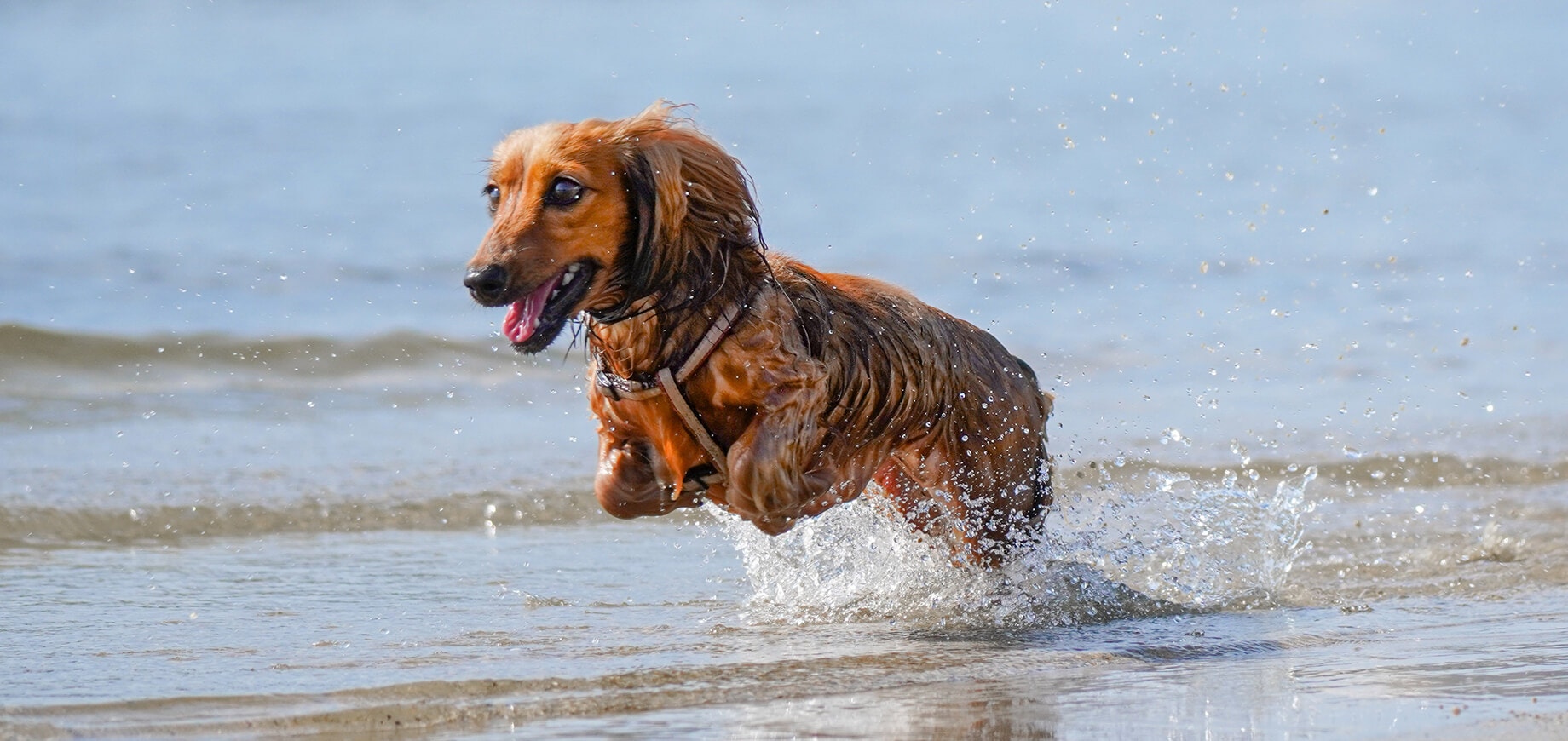

Summer is a great opportunity to spend quality time with your dog! However, dogs in hot weather can quickly overheat, which puts them at risk of heat stroke. That’s why it's essential for dog parents to know how to cool their dogs down effectively. In this article, we outline the signs and symptoms that your dog is overheating, which dog breeds are more likely to overheat and how to help them, as well as general advice on how to keep a dog cool. We also discuss safety precautions that dog parents should take to keep their dogs cool in the summer, particularly in certain situations such as during any exercise or in the car. By being well-informed and planning ahead, you can protect your dog, look after their overall well-being, and avoid any health complications or consequences.
In hot weather, dogs can easily become too hot due to their thick fur and inability to sweat like humans; instead, dogs will pant to keep themselves cool. It’s essential that dog parents look out for the signs and symptoms that their dogs are overheating, as this can potentially lead to heat stroke which can have serious implications for your dog’s health.
To assess whether your dog is getting too hot, look out to see if they are panting heavily, drooling excessively, experiencing vomiting or diarrhoea, or if their gums are bright red or particularly pale. If your dog has uncoordinated movements, lies down and struggles to stand up, or if they are unconscious, this could be a serious sign of a heat stroke. In severe cases, dogs may also experience shaking, seizures, or foaming from their mouth. In any of these situations, call your veterinarian immediately and take steps to cool your dog down. You should move your dog to a shaded area, gently pour cool (not cold) water over their body, and encourage them to drink water.
Some dogs are more prone to overheating than others, depending on their age, breed, coat type and if they have any underlying conditions. For example, flat-faced dogs (such as Bulldogs and Pugs) have short noses and aren’t able to pant as efficiently as other dog breeds, therefore struggling to keep themselves cool. Dogs with thicker or double coats, such as German Shepherds and Huskies, are also at higher risk of heat stroke. Giant dog breeds, like St Bernards, are more likely to overheat due to their larger size, while overweight dogs may struggle due to the extra insulation on their bodies. Dogs with health problems and senior dogs are also more sensitive to heat, and energetic dogs can struggle if they continue with strenuous activities in hot weather. Dog parents with any of the dogs mentioned above will need to know how to cool a dog down effectively.
For some dogs, you may be able to trim their coat during periods of hot weather, however this depends on their breed, coat type and individual needs. Dog breeds with single coats, such as Poodles, can have their coats trimmed to help keep them cool. However, certain dog breeds have double coats (such as Golden Retrievers) which provide insulation in cold weather and protection in hot weather - and trimming these coats can expose them. In any case, you should never trim a dog’s coat too short as this can cause sunburn, and make sure to use dog-safe sunscreen on any areas with less fur or exposed skin. Instead of trimming, you can also regularly groom your dog to remove loose hair and help keep your dog cool.
There are many ways to cool a dog down and keep them safe in hot weather, which we discuss further below.
It’s important to keep your dog cool in the summer by keeping them out of direct sunlight and poorly ventilated areas. For example, you should avoid travelling with your dog on particularly hot days. If it can’t be avoided, cool down the car before placing your dog inside, and consider covering your back windows with a sunshade so your dog isn’t in direct sunlight. Make sure to never leave your dog in the car unattended, even if you’re parked in the shade with the windows down, as there will be poor ventilation and temperatures can quickly rise in the car, causing your dog to overheat. Remember to take a travel dog water bottle with you to keep your dog hydrated.
If you’re taking your dog out for a walk in the summer, try to plan ahead to keep them safe. First, check if the ground is too hot by placing your own hand on it - if you can’t hold it there for more than a few seconds, it’s too hot for your dog’s paws.
Consider taking your walks in the early morning or late evening when temperatures are lower, and choose routes that offer plenty of shade along the way, such as in the park with lots of trees - the grass will be cooler than concrete too. You can also find sheltered areas to take regular water breaks, or let your dog relax in a shaded area of your garden instead.
If it is too hot to take your dog outside, keep your dog cool inside the house. You can encourage them to lay down on tiled floors which can cool dogs down by absorbing some of their body heat. You can also use a fan to facilitate airflow and keep your dog cool inside the house - just be careful if your dog has longer hair.
Water is essential for dogs in hot weather, and is effective at keeping dogs cool and hydrated. Dog parents should ensure their dogs have constant access to clean water and regularly refill their water bowls throughout the day. It’s also helpful to have water bowls in different places around the house, depending on where your dog likes to spend their time - you can use elevated bowls to prevent spills and contamination. Since water can quickly become warm in the heat, consider using freezable water bowls. When out for a walk, even if you’re avoiding the midday sun, it can still be very hot for dogs so take a collapsible water bowl or dog water bottle with you to ensure your dog stays hydrated.
If your dog doesn’t want to drink water, you should check for any other signs of an underlying illness which may be affecting them. If your dog seems lethargic, has changes in appetite, is experiencing gastrointestinal problems such as vomiting or diarrhoea, or showing any other changes in behaviour, consult your vet as soon as possible.
However, if your dog doesn’t have any of the above symptoms, it may be that they are just picky about their water. Make sure their bowl always has fresh and clean water in it by replacing it regularly. Also, try using different types of bowls, or consider using a pet fountain as a novelty to encourage your dog to drink more water. You can also experiment with different water temperatures, in case your dog prefers their water to be warmer or cooler. If all attempts fail, make sure you’re serving your dog wet food and try adding water to their dry food to increase their water intake.
There are various cooling products on the market that can help to cool your dog down by regulating their temperature. For example, cooling mats contain a gel that keeps dogs cool by absorbing their body heat. Use a cooling mat that is suitable for your dog’s size, and make sure it can fit in their crate so you can keep your dog cool at night.
Water activities are great at keeping dogs cool in hot weather, and a fun opportunity to stimulate and play with your dogs. You can purchase an inflatable paddling pool for your garden and fill it up with an appropriate amount of water for your dog’s size, along with their favourite toys, for them to splash around. Alternatively, and especially if you have more than one dog, you can use a sprinkler system as a fun water game to cool your dogs down. If you don’t have a garden, water in a spray bottle will work too - just mist your dog’s stomach to provide immediate relief.
However, with any water activities for dogs, it’s essential that dog parents practise water safety. You should never leave your dog unattended near water. Also, be careful when engaging in water activities with long-haired dogs, as water can add weight to their coats and trap more heat - instead, use water on their stomachs. If you’re taking your dog to a location by the lake or ocean, consider using a life jacket on your dog and keep a close eye on them at all times. Not all dogs enjoy water in the same way or straight away, so introduce your dog to water activities gradually.
There are various other techniques to cool a dog down, including using cold and wet towels, water sprays or ice packs. Remember to look after your dog’s paws in the summer, as the hot ground can burn them, and wetting their paws is a great way to keep a dog cool in the summer.
Wet towels are most effective when used on your dog’s stomach and thighs, as these areas will help cool down your dog quickly. You can also place a wet towel in the crate to keep your dog cool at night. Here are some step-by-step instructions on how to use wet towels on your dog.
It’s essential that dog parents follow safety precautions for their dogs in hot weather, and keep them cool inside the house if necessary. Always avoid walking your dog in the midday sun. If you want to walk your dog in the heat, only take them out at dawn and dusk when the air is cooler. Walk in shaded areas on the grass, rather than on the pavement or sand which retains heat and can burn your dog’s paws, and try not to overexert your dog with strenuous exercise by keeping the walks easy and brief, whilst offering plenty of water on the go. You should also not expose your dog to extreme temperature changes. If you think it’s too hot for your dog, don’t go out for a walk and instead initiate a play session indoors in a cool room. It’s much safer for a dog to miss a walk on hot days than to risk heat exhaustion.
It’s important to familiarise yourself with the signs of an overheating dog, discussed further in our article on walking dogs in hot weather. If you notice any unusual symptoms or changes in your dog’s behaviour, such as excessive panting, lethargy, or if they feel hot to touch, seek veterinary advice immediately in order to prevent serious consequences. You should immediately try to cool down your dog by moving them to a shaded area and offering water to drink.
Also, when cooling down your dog, never pour cold water directly onto them as this can cause shock. Instead, choose cool water and pour it away from their head and onto their body. Be careful when using any frozen treats or toys if your dog loves to chew, as this may damage their teeth. When utilising a wet towel, never place it over your dog as this can trap heat and make their condition worse.
Summer is a glorious time, and it’s natural for dog parents to want to share the sunshine with their dogs too. There are many ways for dogs to enjoy hot weather, whilst staying safe at the same time. Hydration is especially important in the heat, so if you want to support your dog’s water intake, make sure to include PEDIGREE® Wet Dog Food in your dog’s diet. PEDIGREE® Wet Dog Food comes in a variety of flavours for your dog to enjoy, whilst providing essential nutrition through high-quality ingredients for your dog’s overall health and well-being.

